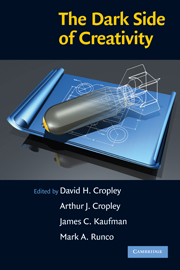Book contents
- Frontmatter
- Contents
- List of Contributors
- 1 The Dark Side of Creativity: What Is It?
- 2 Creativity Has No Dark Side
- 3 Positive Creativity and Negative Creativity (and Unintended Consequences)
- 4 Subjugating the Creative Mind: The Soviet Biological Weapons Program and the Role of the State
- 5 Imagining the Bomb: Robert Oppenheimer, Nuclear Weapons, and the Assimilation of Technological Innovation
- 6 The Innovation Dilemma: Some Risks of Creativity in Strategic Agency
- 7 Early Creativity as a Constraint on Future Achievement
- 8 Boundless Creativity
- 9 Reviewing the Art of Crime: What, If Anything, Do Criminals and Artists/Designers Have in Common?
- 10 Creativity in Confinement
- 11 Creativity and Crime: How Criminals Use Creativity to Succeed
- 12 So You Want to Become a Creative Genius? You Must Be Crazy!
- 13 Both Sides of the Coin? Personality, Deviance, and Creative Behavior
- 14 Neurosis: The Dark Side of Emotional Creativity
- 15 Dangling from a Tassel on the Fabric of Socially Constructed Reality: Reflections on the Creative Writing Process
- 16 Creativity in the Classroom: The Dark Side
- 17 The Dark Side of Creativity and How to Combat It
- 18 A Systems Engineering Approach to Counterterrorism
- 19 Malevolent Innovation: Opposing the Dark Side of Creativity
- 20 Summary – The Dark Side of Creativity: A Differentiated Model
- Index
- References
14 - Neurosis: The Dark Side of Emotional Creativity
Published online by Cambridge University Press: 05 June 2012
- Frontmatter
- Contents
- List of Contributors
- 1 The Dark Side of Creativity: What Is It?
- 2 Creativity Has No Dark Side
- 3 Positive Creativity and Negative Creativity (and Unintended Consequences)
- 4 Subjugating the Creative Mind: The Soviet Biological Weapons Program and the Role of the State
- 5 Imagining the Bomb: Robert Oppenheimer, Nuclear Weapons, and the Assimilation of Technological Innovation
- 6 The Innovation Dilemma: Some Risks of Creativity in Strategic Agency
- 7 Early Creativity as a Constraint on Future Achievement
- 8 Boundless Creativity
- 9 Reviewing the Art of Crime: What, If Anything, Do Criminals and Artists/Designers Have in Common?
- 10 Creativity in Confinement
- 11 Creativity and Crime: How Criminals Use Creativity to Succeed
- 12 So You Want to Become a Creative Genius? You Must Be Crazy!
- 13 Both Sides of the Coin? Personality, Deviance, and Creative Behavior
- 14 Neurosis: The Dark Side of Emotional Creativity
- 15 Dangling from a Tassel on the Fabric of Socially Constructed Reality: Reflections on the Creative Writing Process
- 16 Creativity in the Classroom: The Dark Side
- 17 The Dark Side of Creativity and How to Combat It
- 18 A Systems Engineering Approach to Counterterrorism
- 19 Malevolent Innovation: Opposing the Dark Side of Creativity
- 20 Summary – The Dark Side of Creativity: A Differentiated Model
- Index
- References
Summary
The term “neurosis” was introduced in 1769 by Scottish physician William Cullen to refer to presumed nervous disorders in the absence of discernible neurologic defects. It gained wide currency during the first half of the twentieth century largely through the influence of Freud. Today, “neurosis” is no longer used as a technical term primarily because it is too broad for diagnostic and treatment purposes. Nevertheless, it is still used widely as a generic term for a wide range of disorders of primarily psychological origin. Carl Jung (1965) observed that frequently “people become neurotic when they content themselves with inadequate or wrong answers to the questions of life” (p. 140). This observation provides a good preliminary definition of neurosis. However, an important qualification is needed: Even more fundamental than contentment with inadequate or wrong answers are misdirected strivings for solutions. With this qualification in mind, we can ask: What kind of life questions lead to neurosis? And in what ways are neurotic answers inadequate or wrong? This chapter addresses these questions. Briefly stated, the kinds of life questions that occasion neuroses are those which (a) lead to emotional responses and (b) call for creative solutions. Neurosis results when an emotionally creative response miscarries.
REFLECTIONS ON THREE EARLY WORKS
Elsewhere (e.g., Averill, 1999; 2005; Averill & Nunley, 1992; Nunley & Averill, 1996) we have provided empirical support for emotional creativity, including laboratory research and clinical examples of emotional creativity gone awry. Here we take a different tack.
- Type
- Chapter
- Information
- The Dark Side of Creativity , pp. 255 - 276Publisher: Cambridge University PressPrint publication year: 2010
References
- 6
- Cited by

